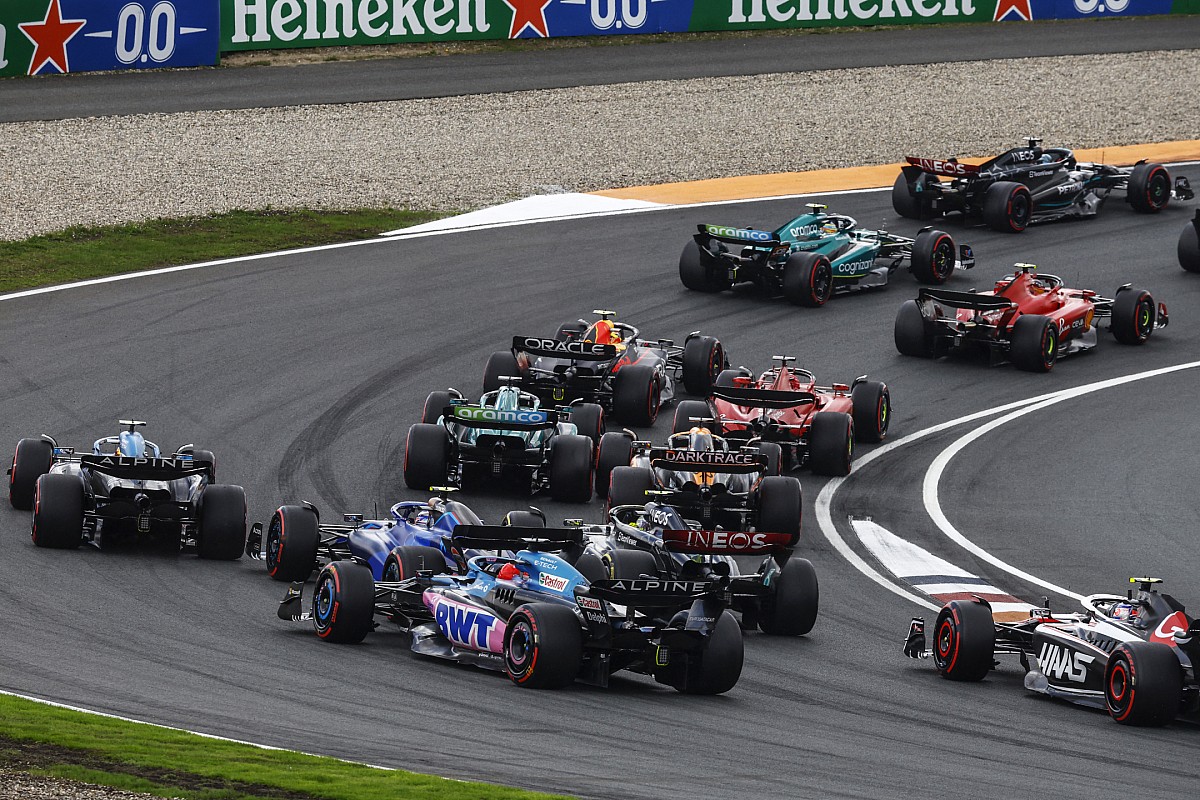- cross-posted to:
- formula1@lemmit.online
- cross-posted to:
- formula1@lemmit.online
As first reported earlier this month, the FIA has been taking a close look at flexible wings over the first half of this season as it believes teams have been pushing the boundaries in terms of what is allowed.
It is understood that several teams, including Aston Martin, were advised to make changes to their front wing designs around the time of the Azerbaijan Grand Prix in a bid to ensure that they did not fall foul of any rule breaches.
But as part of a ramped up effort to stop any attempt at getting around the regulations, the FIA has now issued a formal technical directive outlining what it believes are unacceptable designs with regards to flexible bodywork.
In TD018, a copy of which has been seen by Motorsport.com and was sent to teams ahead of the Dutch GP weekend, the FIA states that it believes outfits are exploiting “regions of purposely design localised compliance” plus “relative motion between adjacent components” to deliver a significant boost to aerodynamic performance.
It states that any design that operates like this is in breach of Article 3.2.2 of F1’s Technical Regulations, which states that all components that influence a car’s aerodynamic performance must be “rigidly secured and immobile with respect to their frame of reference defined in Article 3.3.
Furthermore, these components must produce a uniform, solid, hard, continuous, impervious surface under all circumstances.”
The FIA has been prompted into action because it believes that teams are exploiting sophisticated systems that rotate and flex front and rear wing elements in ways that cannot be detected through the regular load tests.
It has made it clear that any “assembly designs that exploit localised compliance or degrees of freedom are not permitted.”
The FIA has duly outlined four key design elements that it considers to be in breach of the technical rules, but suggests there may be other ideas at play that could be illegal as well.
They are:
-
Wing elements that can translate vertically, longitudinally or laterally relative to the bodywork that they are fixed to.
-
Wing elements that can rotate relative to the bodywork that they are fixed to, such as rotating around one fixing.
-
Designs that utilise elastomeric fillets, compliant sections of wing profile or thin flexible laminate at a junction that can either distort, deflect out of plane or twist to permit localised deflection relative to the bodywork the component is attached to.
-
Designs that utilise ‘soft’ trailing edges to wing elements to prevent ‘localised cracking’ as the result of component assembly deflection.
The only exemptions that will be allowed are in the area of floor assembly, bib bodywork and the opening of a small lateral gap to help the sealing of front wing flaps.
Whereas in the past, teams’ flexi wing antics were often responded to by the FIA increasing the load tests that take place in the garage, the realisation that teams may be using clever trickery to make the wings flex in ways that cannot be checked when the car is stationary has prompted a change of approach.
From now on, teams must submit the assembly drawings and cross sections that show the fixation of the front wing elements to the nose, as well as the rear wing elements to the endplates, rear impact structure and pylons.
Furthermore, teams have to supply similar images that show the fixation of the rear wing pylons to the rear impact structure.
These designs will allow the FIA to better understand how the wing components have been designed and if any team has created its parts in a way to flex and deliver an aerodynamic advantage.
Because of the potential work needed by teams to ensure full compliance with the regulations, the FIA has delayed the adoption of its new stance until the Singapore Grand Prix next month - which means competitors can continue with their current designs through to the end of this weekend’s Monza race.
Teams have been asked to submit all the necessary drawings that show their wing designs by 8 September.
This honestly sounds a bit ridiculous. A team found a new aero design? Cool!
The FIA does not want active aero, this is another rule in a long line of rules to prevent that. IMO now that there are cost caps in place they should get rid of most of these types of rules put in place to control spending.
Its not just spending but intentionally limiting performance due to safety. Current cars and fully active aero would be seconds per lap quicker than the current cars and the current circuits are not designed for that, plus you would be significantly escalating g force putting extra strain on the driver. F1 every few years adjusts regulations to not only shake things up or appear to be greener but to slow down the cars.
Indeed it’s mostly for safety, active aero is difficult to keep in check as demonstrated by this static rule bending years. F1 is a part of technology advancements but just as space it should be done in a safely manner.
Not that I don’t like the idea of a mind blown fast F1 car, all for it. And I think everyone had goosebumps when seeing an Williams from the 90’s moving it suspension in the garage. But we’ve also seen to what all of that let.
For its time the engineering behind that Williams active suspension is insane, its controlled by something that would probably be under powered for a modern washing machine compared to what they would use today. Didn’t they have to program it in assembly to make it fit into the storage they had available? I’mlimitedbythetechnologyofmytime.gif
I’m not saying you’re wrong. I’m saying it’s stupid. If the FIA supposedly are trying to lead the way in technologies that will eventually make their way to consumer automobiles, they should be celebrating advancements in aero. But maybe I’m biased as an aerospace engineer by background.
It’s because the FIA don’t actually care about F1 developing technology for road-cars. If they cared there wouldn’t be huge engine and ERS restrictions, a tire monopoly, and limits on aero innovations (as you pointed out). They use the road-car excuse to either slow the cars down or for commercial/financial gain.
If we’re being brutally honest, do the FIA care about anything other than money?
-
The worst part about this is it probably won’t knock Red Bull back at all, just those trying to catch them.
Red Bull has less aero time. So if they have to adjust their wing they can barely test it.
Is this why Aston Martin have dropped off performance wise?





